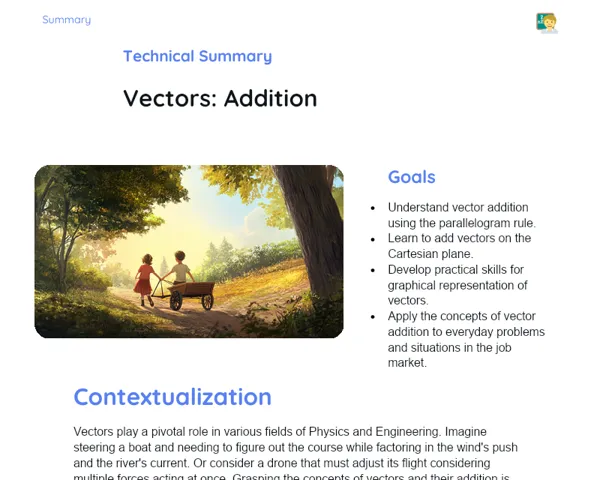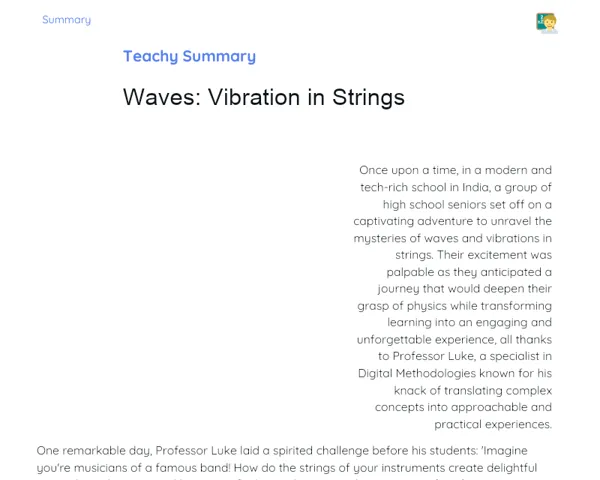Summary Tradisional | Waves: Doppler Effect
Contextualization
The Doppler Effect is a fascinating physical phenomenon that describes the change in frequency of a wave observed from a source that is moving relative to the observer. This effect is something we've all experienced firsthand, like when we hear the siren of an ambulance getting louder as it approaches us and then quieter as it moves away. As the ambulance nears, the sound has a higher pitch, while it takes on a lower pitch as it recedes. This happens because sound waves get compressed when the source draws nearer and spread out, or rarefied, as it moves away.
Beyond our daily experiences, the Doppler Effect holds immense significance in various scientific and technological fields. In astronomy, for instance, it helps us gauge the speed and direction of distant stars and galaxies, enhancing our understanding of the universe's expansion. In the medical field, techniques like Doppler ultrasound use this effect to assess blood flow in different body parts, aiding in diagnosing numerous health issues. Similarly, speed radars, commonly used by traffic police, depend on the Doppler Effect to measure how fast vehicles are going relative to the radar.
To Remember!
Concept of Doppler Effect
The Doppler Effect refers to the change in frequency or wavelength that an observer notices depending on their movement in relation to the wave's source. This phenomenon occurs because waves are compressed as the source approaches and rarefied when it recedes. When a sound source moves closer to us, the sound waves become more compact, leading to a higher frequency and a sharper sound. In contrast, as the source moves away, the waves disperse, resulting in a lower frequency and a deeper sound.
This concept is invaluable for explaining how we perceive sounds in motion in our everyday lives. A prime example is the ambulance siren, which alters its tone as it approaches and then drives away from us. This principle is not limited to sound; it applies to electromagnetic waves, like light, and is pivotal across diverse scientific and technological domains.
Grasping the Doppler Effect helps connect physics with our lived experiences and is essential for understanding how everyday technologies, such as speed radars and medical devices, operate.
-
Change in frequency or wavelength as perceived by the observer.
-
Compression of waves when the source gets closer and rarefaction when it moves away.
-
Applicable to both sound and electromagnetic waves.
Doppler Effect Formula for Sound
The formula for the Doppler Effect in sound waves is expressed as f' = f (v + vo) / (v - vs), where f' represents the observed frequency, f is the emitted frequency, v is the speed of sound in the medium, vo is the observer's speed, and vs is the source's speed. This formula aids in calculating the frequency that the observer perceives under different conditions of motion between the source and the observer.
Each component of the formula serves a unique purpose. The source frequency (f) denotes the original frequency of the sound released by the source. The medium's speed of sound (v) varies based on the material through which the sound travels, like air. The speeds of the observer (vo) and the source (vs) refer to how quickly they are moving relative to the medium.
The formula can be modified based on the direction of movement. If the observer and source are moving closer, the observer's speed is added to the equation, while the source's speed is subtracted. Conversely, if both are moving away from each other, the observer's speed is subtracted and the source's speed is added. This adaptability within the formula facilitates calculating the apparent frequency in a host of practical situations.
-
Formula: f' = f (v + vo) / (v - vs).
-
Each term plays a vital role in determining the apparent frequency.
-
Adjust the formula for scenarios where the source and observer are moving closer or further apart.
Applications of the Doppler Effect
The Doppler Effect finds a wide range of practical applications in various fields. In astronomy, it is instrumental in ascertaining the speed and direction of stars and galaxies, providing insights into the universe's expansion. The terms redshift and blueshift describe this effect concerning starlight, indicating whether celestial bodies are moving away from or towards Earth.
In the medical realm, Doppler ultrasound functions as a crucial diagnostic tool that employs the Doppler Effect to measure blood flow across various regions in the body. This technique is pivotal for detecting problems like arterial blockages or irregular blood circulation, and it offers non-invasive insights into cardiovascular health.
Additionally, speed radars utilized by the police to check vehicular speeds base their calculations on the Doppler Effect. These radar devices emit radio waves that bounce off moving vehicles, which assists in determining their speed in relation to the radar. These real-world applications underscore the importance of the Doppler Effect in contemporary science and technology.
-
Gauge the speed and direction of stars and galaxies in astronomical studies.
-
Doppler ultrasound used for blood flow measurements in medicine.
-
Speed radars employed for monitoring vehicle speeds.
Calculating Apparent Frequency
Calculating the apparent frequency involves applying the Doppler Effect formula to various scenarios. It's essential to recognize how each term influences the ultimate outcome. For instance, if the sound source is coming closer, the apparent frequency will be greater than the original frequency emitted. Conversely, if the source moves away, the apparent frequency will drop.
To gauge the apparent frequency, begin by determining the speeds of the source and observer relative to the medium (like air). Then apply the formula f' = f (v + vo) / (v - vs), making necessary adjustments based on the relative motion. Engaging with practical examples, like the siren of an ambulance as it approaches and then recedes, helps solidify your understanding of the calculation process.
Solving problems systematically aids in internalizing the concept and applying the formula correctly. Moreover, discussing varied scenarios—such as both observer and source moving—enhances comprehension of this phenomenon and its complexities.
-
Identify the speeds of both the source and observer.
-
Utilize the formula f' = f (v + vo) / (v - vs).
-
Practice with real-world examples to deepen understanding.
Key Terms
-
Apparent frequency: The frequency perceived by the observer due to the relative motion between the source and the observer.
-
Doppler Effect: A phenomenon that describes how the frequency of a wave changes relative to an observer who is moving in relation to the wave source.
-
Redshift: Signals that the light source is moving away from the observer.
-
Blueshift: Indicates that the light source is moving towards the observer.
-
Doppler ultrasound: A medical technique utilizing the Doppler Effect to assess blood flow.
-
Speed radars: Devices leveraging the Doppler Effect to compute the speed of moving objects.
Important Conclusions
Studying the Doppler Effect shines a light on how a wave's frequency can change based on the relative movement between the source and the observer. This observable phenomenon plays a crucial role in not only our understanding of how we perceive sounds in motion but also in a variety of scientific and technological applications. From measuring stellar speed in astronomy to medical diagnostics via Doppler ultrasound, grasping this effect is vital.
The Doppler Effect formula facilitates the calculation of apparent frequency in various motion situations, serving as a robust tool for practical problem-solving. Engaging with real cases, like the sound of an ambulance siren, helps students internalize the concept and apply the formula accurately. This understanding is particularly important for high school seniors who need to integrate theory with practical applications.
The importance of the Doppler Effect reaches beyond classroom learning, impacting public safety through speed radars and enhancing medical imaging techniques. Encouraging students to delve deeper into the subject can foster greater comprehension and innovative possibilities, thereby highlighting the significance of continuous learning.
Study Tips
-
Hone your skills by solving problems using the Doppler Effect formula in varied scenarios. This will reinforce your grasp of the concept and its real-world applications.
-
Watch videos or animations that illustrate the Doppler Effect to visualize how wave frequencies fluctuate with relative motion between the source and the observer. This visual aid can clarify the phenomenon significantly.
-
Investigate additional applications of the Doppler Effect beyond those covered in class, such as its role in meteorological predictions and communication technologies. This will broaden your knowledge and showcase the extensive relevance of the concept.



